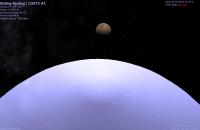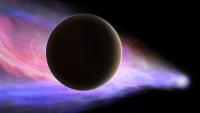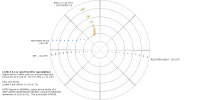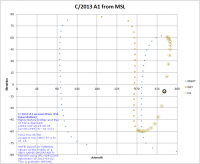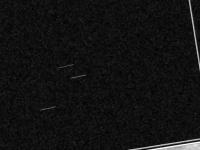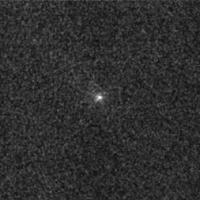Printable Version of Topic
Click here to view this topic in its original format
Unmanned Spaceflight.com _ Past and Future _ Comet observation from Mars
Posted by: MaG Feb 25 2013, 10:07 PM
Is there is any possibility to observe comets in near future from surface of Mars and/or from Mars orbiters. Which types of instruments are possible to use?
For example (http://ssd.jpl.nasa.gov/horizons.cgi - position Mars 0deg Longitude, 5deg south Latitude, time UTC):
1) Comet C/2012 S1 (ISON)
2013-Oct-01 17:19UTC RA 23 07 44.73 DE +69 27 46.0 MAG 2.93 r 1.637007919902 delta 0.07246306543080
So there is relativly very close encounter in October 2013, about 11 million km from Mars..
2) Comet C/2013 A1 (Sidding Spring)
2014-Oct-19 20:59UTC RA 10 49 50.64 DE -60 38 09.5 MAG -8.29 r 1.401218071277 delta 0.00070643344409
There is still maybe not so precise orbit BUT, there is ONLY about 105 000 km (65 000 miles) encounter from Mars.
Especially the second comet, if this orbit will be OK, is very interesting target to observe.
Posted by: CAP-Team Feb 27 2013, 08:44 PM
The sight from mars on C/2013 A1 should be spectacular! I tried to simulate it with Celestia, its appearance in the sky should be huge!
Posted by: mcaplinger Feb 27 2013, 09:01 PM
I think it's a safe bet that any extremely bright comet will get imaged. Dimmer objects will likely not be visible and at some brightness the attempt probably won't be made.
Posted by: Hungry4info Feb 27 2013, 09:31 PM
http://spaceobs.org/en/2013/02/27/new-data-concerning-the-close-approach-of-comet-c2013-a1-to-mars/.
"Today, at the ISON-NM observatory, new astrometric measurements were received for this comet. Based on the existing measurements, more accurate orbital elements were calculated. The results of the second calculation for the close approach show that the comet might pass just 41,000 km (0.000276 a.u.) from the planet’s centre, that is less than 37,000 km from its surface!"
Posted by: mcaplinger Feb 27 2013, 09:38 PM
From that site:
I'm thinking this is unlikely to be a threat to the rovers and probably not to orbiters either.
Posted by: SFJCody Feb 28 2013, 12:59 AM
Less than the apoapsis for India's Mars Orbiter Mission (80,000km).
Posted by: machi Feb 28 2013, 02:05 AM
I'm still missing more excitement about this. ![]()
If flyby distance will be really around ~50 000 kilometers, than this event is comparable to the encounter of Halley comet with so called Halley armada.
We can have up to five orbiters with superior instruments which can probe Hale Bopp class cometary nucleus with cameras and spectrometers in multiple wavelengths.
Some orbiters (MEx, MAVEN, Mangalyaan) have instruments for direct examination of atoms, ions and another particles.
We have flyby worth of one billion dollars for free! ![]()
Posted by: nprev Feb 28 2013, 02:56 AM
Thing is, none of the orbiters have been designed for a comet encounter. I'm a little worried about sandblasting, but also wondering how much ACS fuel expenditure would be needed to do a good job of observation; every burn shortens their operational lifetimes, and this thing will be really moving at closest approach.
I dunno; as the oldest orbiter, might be a good job for MODY. MRO could do something amazing, no question, but doubt that the mission's management would go for more than a set or two of obs, if that.
All that said: Yeah, I'm actually pretty pumped!!! ![]()
Posted by: machi Feb 28 2013, 03:22 AM
Yes, it will not be easy. But I think that all teams, which have spacecrafts around Mars, are very experienced and they will handle it.
BTW, It's even more fantastic. It can be our first close observation of long period comet visiting us directly from Oort cloud!
Posted by: Explorer1 Feb 28 2013, 05:18 AM
How long is MAVEN's commissioning phase anyway? Hopefully a month is long enough to get ready and calibrated.
This whole thing reminds me of Shoemaker-Levy and Galileo all over again, but multiplied many times; including ISON it's less than one Mars year between two close comet encounters; looks like these sorts of coincidences aren't limited to Earth...
Posted by: nprev Feb 28 2013, 05:25 AM
Meh. The wonder of statistics (which are tedious to compute, but always quite fascinating to grasp).
Posted by: mcaplinger Feb 28 2013, 05:33 AM
Both cameras with any resolution on MRO are linescan anyway, so the target moving is a feature, not a bug. It may only be necessary to repoint the s/c, which can be done on the reaction wheels with very little fuel usage. Even if scanning is needed, the wheels can likely do it. A more substantive problem is that the resolution isn't that great -- 125x worse than what we get on Mars (750 meters/pixel for CTX, around 40 m/pxl for HiRISE.)
That said, this is still more than 1.5 years away and the ephemeris and even the size of the comet are uncertain, so detailed planning is premature.
Posted by: fredk Feb 28 2013, 04:31 PM
We've made (and survived) many comet encounters with several spacecraft, at distances of several hundred km down to a couple hundred km (Deep Impact, Stardust, etc). Those were smaller comets, but Giotto survived the Halley encounter at about 600 km. Of course those missions were designed for comet encounters, not for Mars orbit.
My guess, based on flux conservation, is that the density of particles in the coma drops like roughly the inverse square of the distance from the coma nucleus. So even if C/2013 A1 turns out to be Halley class, at a distance of 40 000 km, the density of particles would be thousands of times lower than what Giotto experienced. The latest ephemeris gives 7th magnitude at its brightest from earth, so that sounds like it isn't Halley class, which means the particle density would be even lower. On the other hand, the encounter velocity will be considerably higher for C/2013 A1 than for previous comet encounters, so any dust hits would have a greater impact.
Of course this is still early days, and brightness estimates will be improved. Most crucially, as mcaplinger said, orbital elements will be improved. The big question now is what is the uncertainty in the close-approach Mars distance? The blog quoted above stated that the comet "might pass just 41,000 km... from the planet’s centre". Is that a lower limit? What's the upper limit? That would give us a better sense of what the Mars close-approach distance will be.
Anyway, based on these numbers, I'd expect no real concern for the orbiters, and even less for the rovers.
And I too can't wait for this encounter!
Posted by: tasp Feb 28 2013, 05:34 PM
Looking forward to those Kodak moment pictures this site is famous for!! Even Hubble might snap some compelling images during the passage?
Maybe too much to hope for but possibly there is some fragmentation close to the sun to make an even better show at Mars.
Posted by: Explorer1 Feb 28 2013, 06:27 PM
And for those wondering about an impact, remember: Mars is an even smaller target than Earth, in a very large solar system!
I expect this to go rather like it did with Apophis; the probability of a collision will go up as predictions get more refined, and than it will drop when the error ellipse no longer includes the planet. See here: http://en.wikipedia.org/wiki/File:Apophis_ellipse.svg
In other words, the news might get worse (for Mars's health) before it gets better. Merely passing through the coma/tail seems far more likely.
Posted by: Greenish Feb 28 2013, 07:45 PM
Well, based on the earlier observations (thru 20 Feb, giving nominal 105000 km close approach) http://ssd.jpl.nasa.gov/sbdb.cgi?sstr=C%2F2013%20A1;orb=0;cov=0;log=0;cad=1#cad could be anywhere from 0 to 1.18 million km with a 3-sigma time uncertainty of 260 minutes. If I'm reading it right the 3-sigma error ellipse at close approach is 735000x139000 km across, with the intersection around the 1-sigma contour... so it will take a bit more refining indeed! Of course,we have some time; that link should continue to be updated whenever they update the orbit.
Posted by: stevesliva Mar 1 2013, 12:38 AM
Mostly. With a Whipple shield.
Posted by: SFJCody Mar 2 2013, 06:13 AM
http://tech.groups.yahoo.com/group/mpml/message/28195
Some new astrometric data has been collected. There should be a recalculation of the closest approach distance from Leonid Elenin soon.
Posted by: fredk Mar 2 2013, 06:43 PM
A brief discussion of imaging prospects with MRO in http://www.skyandtelescope.com/news/home/Mars-has-Front-Row-Seat-for-2014-Comet-194306441.html
Posted by: SteveM Mar 3 2013, 01:19 AM
Some new astrometric data has been collected. There should be a recalculation of the closest approach distance from Leonid Elenin soon.
Mont Carlo solution of approach to Mars at http://tech.groups.yahoo.com/group/mpml/message/28196.
Posted by: SFJCody Mar 3 2013, 03:40 AM
I just find it extraordinary that an object of 10 to 50km diameter has a non-negligible possibility of hitting any of the terrestrial planets. The very idea seems in complete opposition to the principle of mediocrity. This thing would dig a crater at least twice as big as Copernicus on the Moon, and even that is so old that it predates the evolution of complex life on Earth. That we should be here at just the right time to see something like this slam into our neighbour just strikes me as astronomically unlikely.
Posted by: volcanopele Mar 3 2013, 04:42 AM
Playing around with the current trajectory (from MPEC 2013-E06 issued a few hours ago) in Celestia:
The nucleus of C/ 2013 A1 rises above the local horizon at Curiosity at around 19:30:42 UTC @ 334 deg. (NNW) when the comet is 54,387 km from the rover. That's a couple of minutes after closest approach. This is in the late afternoon for the rover. The comet continues to rise in the northern sky. When the comet is 100,000 km from the landing site at 19:53:40, the nucleus is 46.5 degrees above the horizon at an azimuth of 344 deg. When the sun sets at 20:26:49 UTC, the comet's nucleus is 202,840 km away (AZ=338 deg, ALT=61 deg). The nucleus sets in the western sky on October 20 @ 02:12:08 UTC when it is at at distance of 1,359,200 km.
Opportunity gets to look at the comet on the inbound leg with the comet setting at 19:31:53 UTC @ 28.5 (NNE) when the comet is 55,283 km from the rover. That's three minutes after closest approach during mid-morning for Oppy. At 19:26:44 UTC, the nucleus will make its closest pass to Opportunity when it is 52,539 km away (AZ=20.75 deg, ALT=16.5 deg). When the sun rises at 17:48:17 UTC, the comet's nucleus will be 334,450 km away (AZ=56.9 deg, ALT=87.3333 deg). The comet rises in the eastern sky on October 19 at 11:34:19 UTC (middle of the night) when it is 1,590,000 km away. It rises again on October 20 at 23:45:26 UTC (ENE) when the comet is 867,230 km from Oppy.
Closest approach to Mars according to JPL Horizons data ported into Celestia is on October 19, 2014 @ 19:27:37 UTC. The distance from the surface is 50,130 km. The Comets C/A distance to Phobos is 53,326 km and to Deimos it's 51,618 km. From Mars' perspective, the comet is inbound over the planet's dawn hemisphere and outbound over its dusk hemisphere.
Posted by: Don1 Mar 3 2013, 06:42 AM
Shoemaker-Levy 9 passed within 70,000 km of the center of Jupiter and collided with the planet. Even in the past 20 years there is another case of a kilometer scale object coming this close to a planet. I think that the rate of large impacts at Mars and beyond may be a great deal higher than people had previously assumed.
This thing is a planet killer. If it hit Mars, it would make at least a Gale Crater size hole.
The other comets to be well imaged are all short period comets with an aphelion of under 6 AU. C/2013 A1 comes from the Oort cloud, so it may look significantly different from the others. Hopefully HiRISE can get a 40m/px images of this thing, and CRISM can detect the minerals on the surface. THEMIS may be able to resolve the nucleus in the thermal IR and measure its temperature. MAVEN can do fields and particles science on the coma. Mars Express may also get low resolution images, spectra and particles data.
Posted by: Explorer1 Mar 3 2013, 07:09 AM
Yes, that's a good point. First ever Oort object to be seen even remotely close up. Observations from Mars surface/orbit should be planned for basically that reason alone, even ignoring the visuals....
Posted by: rlorenz Mar 4 2013, 06:11 AM
The VEGAs actually fared less well in some respects, even though they were 10 times further out than Giotto (maybe encountered a jet?)
http://www.lpl.arizona.edu/~rlorenz/solararraydamage.pdf
Posted by: SFJCody Mar 4 2013, 06:24 AM
Belatedly realised that what I said above was pretty silly. Was trying to think of young (<100Ma) craters in the inner solar system that are around 200km in diameter or greater, and for some reason the word 'Chicxulub' never occurred to me...
Posted by: SteveM Mar 5 2013, 03:17 PM
Checked the flyby on NASA's Horizons and found that the elongation of the comet from the Sun remains in the range 84° to 90° throughout the encounter.
According to the current model, Mars will never be "downstream" from the comet so won't be as strongly impacted by the outflow of the coma as it would be if it passed directly through the tail.
Steve M
Posted by: Phil Stooke Mar 5 2013, 04:42 PM
"This thing is a planet killer." (Don1)
It might not kill Mars but it might be a rover killer. Depending on location it could darken the skies long enough to really hurt Opportunity. But the chance of that happening is very small - luckily for us rover-lovers.
Phil
Posted by: fredk Mar 5 2013, 06:57 PM
The http://ssd.jpl.nasa.gov/sbdb.cgi?sstr=2013A1;orb=0;cov=0;log=0;cad=1#cad now lists the "nominal" close-approach distance at a bit over 50 000 km. But they list the "maximum" distance as over 300 000 km. I can see no definition for the "maximum" distance, but elsewhere they refer to 1-sigma uncertainties. So if that "maximum" distance corresponds to the 1-sigma upper limit, then it will be a much better indication of the likely close-approach distance than the "nominal" value, if the errors used in the calculations aren't overestimated. In fact, for a gaussian error distribution, the odds are something like 32% that the actual value will be greater than 300 000 km!
The "minimum" distance is listed as zero, which presumably means the error ellipse still intersects Mars. But the area of Mars is an incredibly tiny fraction of the area of a 300 000 km (or 600 000 km?) error ellipse, so the chance of collision is extremely small.
That's interesting - it would mean that the comet would be viewed perpendicularly to the tail throughout the encounter, which is great news for getting good tail views (or at least views that aren't very foreshortened). But if the error ellipse still includes Mars, the comet could as easily be on one side of the planet as the other during encounter. It could also be sunwards or outwards, presumably by as much as something like the 1-sigma value, 300 000 km. So all options still seem to be open. It looks like we'll need lots more observations before we can pin down the encounter specifics.
Posted by: Greenish Mar 5 2013, 08:33 PM
Per http://ssd.jpl.nasa.gov/?horizons_doc#ca the Max/Min values are "formal 3 standard-deviations with linearized covariance mapping" so pretty much inclusive given the HORIZONS error model.
For fun and knowing as above that it's probably entirely wrong, and is certainly not right given the unknowns, here's how the current nominal orbit of C/2013 A1 could look from MSL's position.
Posted by: MaG Mar 5 2013, 09:42 PM
As far as I have read, nobody else said something about size of nucleus, only Leonid Elenin. I think, it's very hard to predict it now, but Jakub Cerny (my friend) wrote an http://www.kommet.cz/page.php?al=jak_je_velke_jadro_siding_spring, that the size of nucleus must be much smaller. For example if you remember comet Hale-Bopp, it was much much brighter in the same distance. And we hope, that it's nucleus is 40 +/- 20 km. So comet's Sidding Spring nucleus is maybe much smaller, Jakub said about 3 to 8 km (derived from their nucleus brightness).
I hope there will be no collision in the future, but if so, even 5 km nucleus is very much. There is no doubt..
Thank you for information about possibilities of imaging by orbiters and rovers.
Posted by: JRehling Mar 5 2013, 09:45 PM
To SFJCody's interesting thoughts about the unlikelihood of seeing a very large impact in our lifetime, I think the key points are:
1) Near misses, if you define them as having about 250x the cross section of the planet, will happen almost 250x more often than actual events. If Chicxulub events occur every 50 million years at Earth, there will a Chicxulub-sized near miss every 200K years.
2) If you count four bodies (Venus, Earth, the Moon, and Mars) as targets of interest, you divide that roughly by four, so every 50K years.
3) The martian cratering rate, per unit surface area, is about 2x the Moon's. But for near misses of a given distance, surface area is irrelevant, and we get a martian rate of about 8x the Moon's. So for Mars alone, we expect one such event every 25K years.
4) The pass is not known to be this close and we'd have to integrate over the possible trajectories to rate it fairly, but this may be considerably further, and so we get further reduction.
5) A generalization/extension of (3): There's a logical fallacy of taking the most unlikely thing that you observe/forecast and noting how weird it is that it happen. What was the probability that you would receive the phone number you were assigned at random? Near zero for that precise number, but the probability that you would get A number about which you could make that comment is near unity.
The solar system allows for many weird catastrophic events that could happen, and cumulatively the probability of one of them happening is much higher than the probability of any one of them. We could have seen a collision form Saturn's rings, but we didn't. We could have seen volcanic activity repave Venus's whole surface during our lifetimes but we didn't. We could be seeing a nearby red giant go supernova but we're not.
Given that the Mars event is looking like a once-every-few-thousand-years event and there are innumerable comparably striking (no pun intended) events we could make the same comment about, it doesn't seem so strange that we're seeing one of them.
Posted by: fredk Mar 5 2013, 09:46 PM
Thanks for pointing out that documentation, Greenish. So 3-sigma means that the odds are only about 0.3% for the actual value to be greater than 300 000 km. This assumes gaussian errors and that the linearized error propagation is accurate.
Posted by: tolis Mar 5 2013, 09:47 PM
The view from Earth may offer an interesting twist; assuming that the coma is extensive enough, Mars itself may project its shadow on it.
In addition, a particle in the coma moving at 56 km/s would clear the shadow in, say, 100 sec so small enough particles should cool down considerably
during that time. Thermal infrared, anyone?
Posted by: akuo Mar 6 2013, 07:22 AM
Even if the nucleus of C/ 2013 A1 doesn't hit Mars, it will still have an effect on the Martian atmosphere. The coma and maybe the tail will cause a great meteor storm on the Martian sky. Most of the meteors would be very tiny specks of dust, but they would still be visible as shooting stars.
Meteor showers on Earth are caused by trails of comets long past, so the approach of an actual cometary coma must be a much more significant event in this sense.
Posted by: volcanopele Mar 6 2013, 08:34 AM
I am doubting the 50 km size as well, though for a different reason. While most comets we've seen upclose are very dark, they have also been close to the sun repeatedly. This is likely this comet's first trip close to the sun and it probably retains a significant amount of ice on its surface. So it probably much higher albedo. Assuming, an albedo of 0.5, its diameter should be around 16 km. Assuming a diameter close to 1, its diameter would be closer to 10 km.
Posted by: Greenish Mar 6 2013, 12:50 PM
http://neo.jpl.nasa.gov/news/news179.html
Comet 2013 A1 (Siding Spring) will make a very close approach to Mars in October 2014
NASA/JPL Near-Earth Object Program Office, March 5, 2013
Currently, Mars lies directly within the range of possible paths for the comet and we can't exclude the possibility that the comet might impact Mars. Our current estimate for the impact probability is less than one in six hundred and we expect that future observations will allow us to completely rule out a Mars impact.
...
Although the current heliocentric orbit is hyperbolic (i.e., eccentricity greater than one), the orbit is elliptic when expressed in the frame of the solar system's barycenter. After more than a million year journey, this comet is arriving from our solar system's distant Oort cloud. It could be complete with the volatile gases that short period comets often lack due to their frequent returns to the sun's neighborhood.
During the close Mars approach, the comet will likely achieve a total visual magnitude of zero or brighter as seen from Mars-based assets.
...
Also includes illustration of brightness curve.
Posted by: fredk Mar 6 2013, 03:31 PM
October 2014 will be well into southern spring, around solar longitude 210 or 220 degrees, a time when tau at Oppy is typically getting up around 0.8 or 0.9. So unfortunately opacity will limit visibility of the tail and coma somewhat. On the other hand, Oppy won't be in the dead of winter and so may have power to do limited nighttime observations. I mention Oppy because her pancam L1 appears to be the fastest optical system on the ground. Of course if the comet gets insanely bright, opacity and optics won't matter so much...
Posted by: DDAVIS Mar 12 2013, 02:52 AM
I wonder if it would be worth having Curiosity try to shoot a minute of 720P video near the zenith at the time of maximum local exposure to the coma. Success or failure to see bright enough meteors would be informative. It could be a unique look at a super meteor storm.
Posted by: ugordan Mar 12 2013, 12:55 PM
I'm not sure the video-capable Mastcam is well-suited for catching meteors on account of having fairly narrow FOV. Navcam would be a better candidate, but unfortunately it can't capture high frame rates.
Posted by: machi Mar 12 2013, 01:26 PM
MAHLI is video capable and has relatively large FOV (39.4°×31.1°). It's not so big as the NavCam's FOV (45°), but it's bigger than FOV of the M-34 (20°×15°).
Posted by: fredk Mar 12 2013, 04:28 PM
The more important thing is the overall camera system sensitivity (ie optical system speed plus CCD sensitivity). MH (and presumably MC, and definitely navcam) are quite slow, as the recent night sky imaging demonstrated. So if you see nothing, you can't be sure that you didn't miss many meteors below your limit.
It might be worthwhile, though. We'd need to estimate the faintest meteor that MH could detect.
Posted by: Explorer1 Mar 27 2013, 11:25 PM
Press release about Siding Spring:
http://science.nasa.gov/science-news/science-at-nasa/2013/26mar_marscomet/
Looks like MAVEN won't be fully commissioned until 2 weeks after CA, but there could be lingering effects. Everything in orbit and on the surface should get a show for the cameras. First I have heard about the aurora possibility.
The odds are a 1 in 2000 chance of impact at this point.
Posted by: xflare Mar 28 2013, 09:17 AM
The nucleus has shrunk a lot. 1-3 km now? It was "upto" 50km before.
Posted by: nprev Mar 28 2013, 01:27 PM
Don't confuse estimates based on constraints with actual measurements. The 50km upper limit was based on early albedo predictions; as the comet gets closer these will be refined based on observations.
In other words, the nucleus didn't shrink from 50km to 1-3km.
Posted by: DEChengst Mar 28 2013, 06:27 PM
If Mars ploughs through the coma and/or tail SAM may do some great measurements as well. Would be interesting to see how atmospheric composition changes over time if at all.
Posted by: fredk Mar 28 2013, 06:45 PM
Tails/comas are extremely tenuous. I'd be very surprized if a pass would leave any measurable effect, even in Mars's thin atmosphere.
Posted by: TheAnt Mar 29 2013, 04:37 PM
The total amount of gas the comet might add could be a few litres of gas at ordinary atmospheric pressure at Mars - in short any addition will most likely be unmeasurable.
That said without considering the effect on one quite unlikely collision - if that happens the effect could be dramatic - possibly even result in a continuous rewriting of the textbooks for the martian atmosphere over the foreseeable future.
What's interesting is that NASA seem to be looking into the option of having any or perhaps all orbiters having a look at the comet, since the comet might be passing as close as a few 100 000 of kilometres and even closer, this could turn out to be one opportunity to get a comet exploration mission for free. =)
Posted by: Cosmic Penguin Apr 11 2013, 06:22 AM
OK I need some expertise about spacecraft methane detection: http://www.dnaindia.com/scitech/1819996/report-dna-exclusive-comet-mars-isro-s-rs450cr-dream-mission claims that the Indian Mars Orbiter may be delayed from this year's launch window because the comet may affect the operation of one of its science instruments, the methane sensor. It quote an un-named scientist saying that "Most comets have methane, and there is a good chance that our MSN payload (methane sensor) may confuse the methane it detects from the comet as that of Mars and transmit wrong data. Such data will mislead us. Even NASA is wary. " ![]()
Somehow I think that this should never been a problem - in fact that little spacecraft is in such a high elliptical orbit that it is in the prime position to make observations of the comet tail, so it seems strange that the Indians think that there's a data contamination problem - they could just delay the instrument's observations if this really is a problem, which again I doubt (or just record the before and after comet passage data for comparison). Hmm.... does that mean something else is going on with the testing of the spacecraft? ![]()
Can any expert on trace gases shed some light on the credibility of this claim? Thanks!
Posted by: Paolo Apr 11 2013, 06:12 PM
I am not sure but I think that it the comet really was able to deliver methane in the atmosphere, it would be extremely interesting to study its dynamics and the mechanisms that should be quickly destroying it
Posted by: Mongo Apr 13 2013, 02:36 PM
http://www.universetoday.com/101437/new-calculations-effectively-rule-out-comet-impacting-mars-in-2014/
While the latest orbital plot places the comet’s closest approach to Mars slightly closer than previous estimates, the new data now significantly reduces the probability the comet will impact the Red Planet, JPL said, from about 1 in 8,000 to about 1 in 120,000.
The closest approach is now estimated at about 68,000 miles (110,000 kilometers). The most previous estimates had it whizzing by at 186,000 miles (300,000 kilometers).
Posted by: Explorer1 Apr 16 2013, 04:48 PM
Even that distance is pretty much a stone's throw, only about four and a half times farther than Deimos' orbit. It should be quite a show!
Posted by: Paolo Apr 16 2013, 05:20 PM
and we've never recorded such a close approach by a comet to Earth. the closest a comet came, in 1491 was still 1.4 million kilometers away!
Posted by: fredk Apr 16 2013, 06:02 PM
I'll never forget the eerie sight of IRAS–Araki–Alcock gliding past the stars in real time back in '83, and that comet only came as close as just under 5 million km from Earth! But you could only see it's motion in real time through a 'scope.
At 50 km/s relative to Mars and a close-approach distance of 100 000 km, that gives an angular speed of about 1.7 arcmin/sec for 2013 A1 (Siding Spring). So it would take around 17 seconds to cross a half degree (diameter of full moon seen from Earth). So the motion might just be noticeable to the unaided eye in real time, especially if it passed close to a bright star. A farther close approach means smaller angular speed.
I suspect much of the general public thinks comets zoom across the sky, so they wouldn't be impressed by this. But it's exceedingly rare to be able to see solar system motions in real time. Close asteroid passes and eclipses and transits are the only other examples I can think of.
Posted by: Explorer1 Apr 16 2013, 06:36 PM
Yes, many folks confuse comets and meteor speeds, even people I know. Though it's as great an opportunity as any for education!
Posted by: Pertinax Apr 26 2013, 05:13 PM
I was tinkering in the iPad app Luminos with C/2013A1 as it passes by Mars next year using the most ephem., and though I'd pass on the viewing info I put together (at this early date) for MSL:
Comet C/2013 A1 rises on MSL sol 738 at 17:25:58 LT (20:21:39 UTC 19Oct14) at Gale Crater while it is 72,784 km away (from Gale). [Az: 112D 12M 33.1S, Alt: -0D 0M 35.8S] This will likely be behind Mt. Sharp from Curiosity's perspective.
The sun at comet rise is 0D 56M 35.0S above the horizon (Az: 255D 2M 20.0S), preparing to set at 17:35 LT (20:31 UTC)
Closest Aproach to Gale Crater occurs at 17:28:54 LT (20:24:39 UTC) at 72,092 km away [Az: 110D 32M 42.6S, Alt: 8D 27M 28.2S] Luminos calculates the apparant brightness at about -10.5 (FWIW)
The apparent motion since rising to this point has on average been: Az: 0.555D/min, 0.009D/sec; Alt: 2.816D/min, 0.047D/sec; The comet will be traveling across the sky at 0.048D/sec, covering the average angular diameter of the moon (0.528D) as seen from earth in 11 seconds (all times for motion here using earth clock).
One hour (Local Time) after sunset, 18:35 LT (21:32:34 UTC), the comet will be at Az: 331D 16M 12.1S, Alt:81D 47M 16.2S and 239,340 km away from Gale. Luminos calculates the apparant brightness at about -7.0 (again, FWIW. I do not know how Luminos calculated apparent mag.)
-- Pertinax
Posted by: Phil Stooke Jul 19 2013, 12:36 AM
Interesting presentation http://mepag.jpl.nasa.gov/meeting/jul-13/files/Comets_by_Mars_MEPAG.pdf - it will actually happen next week at http://mepag.jpl.nasa.gov/meeting/jul-13/index.html:
Phil
Posted by: SteveM Jul 19 2013, 03:46 PM
Powerpoint version (with color) http://mepag.jpl.nasa.gov/meeting/jul-13/files/Comets_by_Mars_MEPAG.pptx
Posted by: fredk Sep 24 2013, 05:02 PM
Update (with further links) on the Mars observations of ISON http://www.skyandtelescope.com/news/home/Comet-ISON-to-Fly-By-Mars-225022822.html About the August hirise attempt:
Posted by: monitorlizard Sep 27 2013, 11:37 AM
The 20 September 2013 issue of Science (page 1328) has what I hope is an example of sloppy reporting and not a revised estimate of comet 2013 A1 at Mars. The exact quote:
"In late 2014, comet 2013 A1 is expected to barrel into Mars, the kind of spectacle last witnessed when comet Shoemaker-Levy 9 bombarded Jupiter in 1994...comet 2013 A1 should kick up a massive dust cloud for Mangalyaan and MAVEN to feast their sensors on."
The article doesn't quote probabilities of an impact, just states it outright so I suspect it does not reflect current thinking.
Posted by: Greenish Sep 27 2013, 03:44 PM
Indeed, that's not consistent with the latest trajectories. The JPL small bodies database browser http://%20http://ssd.jpl.nasa.gov/sbdb.cgi?sstr=C%2F2013%20A1;orb=0;cov=0;log=0;cad=1#cad%20 that the uncertainty is now down to 16 minutes in close approach using observations from Sept, and has increased to 5.8 sigma from an impact trajectory. The nominal distance is 134000 km, minimum 66400/max 201000 km (I think these are 3-sigma).
That's some surprisingly dramatic language for Science.
Posted by: JohnVV Sep 27 2013, 08:56 PM
For those interested
i posted a "preview" using the ISON and "siding spring" naif kernels
as seen from Gale Crater for both comets
all 3d renderings using Celestia
ISON
https://picasaweb.google.com/102695901291398562941/ISONFromGaleCrater
Siding Spring - renderings of the comet( random generated 3d mesh)
https://picasaweb.google.com/102695901291398562941/CometSidingSpringC2013A1
the rover will have SOME VIEW
-- Comet rise on Oct 19 2014 from Gale
http://imgbox.com/adsYEiBo
the config files can be found here
http://forum.celestialmatters.org/viewtopic.php?f=18&t=578
Posted by: scalbers Sep 28 2013, 03:41 PM
I get a magnitude for ISON of about +4.1 seen from Mars at closest approach, assuming +11.5 seen from Earth on Oct 1 2013.
For 2013 A1 "Siding Spring" in October 2014 I get about -7.8 magnitude as seen from Mars.
Posted by: jamescanvin Sep 29 2013, 12:13 PM
Looks like Opportunity had a go at taking a navcam image of ISON yestersol (3441). No images available yet though.
Posted by: Deimos Sep 29 2013, 06:15 PM
I get magnitude 5.5 from Mars, based on >13 from Earth at this time. And that'll be a bit spread out as seen from Mars. And through dust, for the rovers. Hard to say ISON would be more visible than, say, M31.
Siding Springs will be bright, but spread out--mostly, the surface brightness may not be even visible--except that for it, the nucleus can be detected by things other than HiRise.
I don't know about using Navcam, as opposed to Pancam, from MER. It is not nearly as sensitive, with a bit of neutral density coating.
Posted by: Astro0 Sep 30 2013, 07:54 AM
Mars Exploration Rover Opportunity - Sol 3441
It'd be nice if ISON were in there somewhere and someone could pull it out.
Lots of noise and cosmic ray strikes to filter through.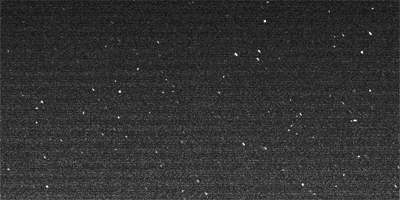
Six images:
1P433703396ESFC8MDP2730L1M1 3441 23:37:35 -78.9 330.2
1P433703436ESFC8MDP2730L1M1 3441 23:38:14 -79.0 330.9
1P433703536ESFC8MDP2730L1M1 3441 23:39:52 -79.2 332.7
1P433703576ESFC8MDP2730L1M1 3441 23:40:31 -79.3 333.5
1P433703676ESFC8MDP2730L1M1 3441 23:42:08 -79.4 335.4
1P433703716ESFC8MDP2730L1M1 3441 23:42:47 -79.5 336.2
Posted by: Gerald Sep 30 2013, 01:36 PM
This may or may not show ISON: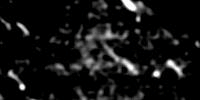
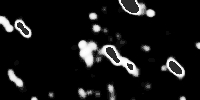
Subframes have been registered (including rotation 0.2 degrees).
Blur, appropriate stretching, and intersecting for the combined jpg, squeeze out a feature of the three longer-exposed images, that looks a little different from stars (different angle, possible relative motion, less sharp) and noise.
But it's hard to tell, whether it's a significant signal.
Posted by: fredk Sep 30 2013, 03:11 PM
I'm sceptical that we're seeing anything. Here's my quick attempt at reducing noise by taking four differences of the three long-exposure frames, registering them, and averaging. Unfortunately the noise is so large that the result doesn't show stars much better than the original frames. Also, I didn't correct for field rotation, so that makes trails look a bit fuzzier away from centre.
Gerald's field is pretty much dead centre in this full frame view. I suspect we're just seeing noise. You'd need the original raw frames to subtract the noise properly.
Can anyone get an accurate position for ISON from planetarium software?
Posted by: Gerald Sep 30 2013, 06:19 PM
FredK's image after enhancing the center of the largest object less bright than stars and brighter than background:
Intermediate processing steps http://makeagif.com/9umBjP.
Posted by: brellis Sep 30 2013, 06:58 PM
Another probably silly question: can one of the orbiters point towards the comet?
Posted by: xflare Sep 30 2013, 07:11 PM
what time is closest approach to Mars?
Posted by: fredk Sep 30 2013, 07:32 PM
Closest approach for ISON shouldn't matter too much, since it's so far away. It will matter much more for next year's coment.
Posted by: JohnVV Oct 1 2013, 08:26 PM
what one
ISON i am not sure
For C/2013 A1( siding spring ) I think it is about 18:30 UT on Oct 19 2014 give or take about 15 min .
Posted by: Explorer1 Oct 2 2013, 02:25 AM
HiRISE twitter claims that images will be down in the next day or so, and business as usual is going on there.
https://twitter.com/HiRISE
Posted by: James Sorenson Oct 2 2013, 03:26 AM
M100 images from Sol-408. This image, according to Starry Night, ISON should be in there, but its not visible.
http://www.flickr.com/photos/43581439@N08/10045402464/
Original animated GIF
http://www.flickr.com/photos/43581439@N08/10045402464/sizes/o/in/photostream/
Posted by: dilo Oct 2 2013, 04:20 AM
This early morning, looking to "just released" material, I found http://mars.jpl.nasa.gov/msl-raw-images/msss/00393/mcam/0393ML1621007000E4_DXXX.jpg image and http://mars.jpl.nasa.gov/msl-raw-images/msss/00393/mcam/0393ML1621008000E1_DXXX.jpg image and, initially, I believed that the very bright object with apparent halo was the comet! ![]()
However, looking to the time when pictures were taken (Sol393) I realized that these are "just" over-exposed Phobos pictures before the eclipse (there is also a totality image http://mars.jpl.nasa.gov/msl-raw-images/msss/00393/mcam/0393MR1622017000E2_DXXX.jpg)... ![]()
Posted by: fredk Oct 2 2013, 04:38 AM
Yeah, it looks like the comet is faint. Here's my shot at recovering it. I've taken four distinct differences from the four longer-exposure M100 frames and averaged them all (with rotation to account for the different observation times for the two pairs). This gets the S/N way up there for the stars James highlighted (sigma, rho UMa), but I don't see anything at the comet's location on James' map:
Maybe there's some kind of threshold effect here - the S/N is so good for those stars that I'd expect to see more stars, but I can't. It looks like I've increased S/N for the obvious stars without bringing out any new ones. Obviously the original raw images would work better.
Posted by: xflare Oct 2 2013, 06:04 AM
I think this is something that will require the original high quality RAW files to detect - if it's visible at all that is.
Posted by: Greenish Oct 2 2013, 02:19 PM
Of the pre-dawn Sol 408 images that have come down so far, all except http://mars.jpl.nasa.gov/msl-raw-images/msss/00408/mcam/0408MR1689003000C0_DXXX.jpg have "E" in the filename, which according to the SIS means they are JPEG 422; the one linked has "C" which means lossless compression was used. (Of course, they are all JPEG-ed [again?] for posting on the web). I don't know if the uncompressed versions are stored on board or if the "E" files were originally stored as JPEGs, but I think it means they are actually compressed in the camera instrument.
Edit: checking a few of them, it looks like the web-posted files are all JPEG quality 70, but the "C" files do have subsampling turned off. FWIW.
Posted by: fredk Oct 2 2013, 02:57 PM
There's also this C frame:
http://mars.jpl.nasa.gov/msl-raw-images/msss/00408/mcam/0408MR1689001000C0_DXXX.jpg
The C frames appear in greyscale on the jpl jpeg site.
Posted by: mcaplinger Oct 2 2013, 03:06 PM
The camera can either take JPEG images in "immediate" mode, in which case the raw image is never stored anywhere, or in "deferred" mode, in which case the raw image is stored in camera flash and JPEGed when transmitted. In the latter case we can send it in any compression mode we want, or no compression at all, or transmit it multiple times in multiple modes.
For MAHLI, if we have the image as a JPEG, the web image is exactly the JPEG bits that we have. For Mastcam and MARDI, the web image is always a decompressed-recompressed JPEG version.
The web image is always JPEG even if we have a lossless version of the image.
I think you can rest assured that if we see the comet, we will make that fact known.
Posted by: fredk Oct 2 2013, 03:34 PM
Incidentally, you can see that the fields in the sol 3441 Oppy pancam sequence and the 408 MSL sequence are the same if you compare my two images above. Comparing them you can also see that Oppy picks out the stars considerably better, as you'd expect for the L1 open filter setting.
By my estimation, the Oppy sequence was taken about 7 hours after the MSL sequence (someone should check this). I wonder how much ISON would've moved against the stars in that time. Perhaps someone could repeat James's rendering showing ISON at the time Oppy took her images - this is clearly our best shot at spotting ISON.
Posted by: Explorer1 Oct 2 2013, 04:27 PM
MRO got it:
http://www.uahirise.org/releases/ison.php
Posted by: Greenish Oct 2 2013, 04:28 PM
mcaplinger, thank you for the explanation .... I was hoping you could provide some insight. The difference between the data paths for MAHLI vs the other MM cameras is interesting, too.
Posted by: fredk Oct 2 2013, 05:30 PM
Here's a stack of the four hirise frames, with 1 pix gaussian blur and a bit of linear stretch:
A hint of some extension towards the upper left?
Posted by: James Sorenson Oct 2 2013, 06:44 PM
Here is the Starry Night Star map overlayed ontop of Fred's image from Oppy. It corresponds very nicely with Gerald's identification of ISON in Pancam images. I'm now fairly confident that what we are seeing is ISON with Pancam. ![]()
http://www.flickr.com/photos/43581439@N08/10057726626/
Posted by: fredk Oct 2 2013, 08:35 PM
Thanks a lot for rendering that, James. I don't see any sign of a trail at that location, so I'm sceptical we're seeing ISON. I suppose based on the hirise images that ISON should appear essentially pointlike to pancam?
ISON is relatively close to Mars, so it should matter if the Starry Night map shows ISON where it would appear from the centre of Mars vs Oppy's location - are you using Oppy's location?
In case the position is off somehow, it looks like all of the trails match with Starry Night stars, except possibly the trail immediately below the label "C/2012". Is there a star at that position (it may be covered up by the "C")?
Posted by: Deimos Oct 2 2013, 08:58 PM
There are two Hipparcos stars partially overlapping that label. The one you point out is Vmag 7.6! Pancam is quite red-sensitive compared to Mastcam. Both of those stars are K-type. For hot stars, Mastcam wins, by the way. I'm skeptical of any comet ID in the Pancam or Mastcam, although the reported locations are about right. I'm still on the lookout for more MER goodies, but am not optimistic about the comet.
I don't know much about the HiRise images, but they seemed near the noise threshold, and HiRise has a bit more optics to throw at the comet than Pancam does.
Posted by: James Sorenson Oct 2 2013, 10:18 PM
Fred that is correct, ISON shouldn't have a trail that follows the stars, but should move between long exposure frames and have its own movement or trail if the images were taken with very long exposure. In my opinion, Gerald's heavily processed images do make a good case that it's the comet based on aligning the stars in his image and what starry night spits out, ISON's position aligns very well with his candidate. I'm curious though exactly how he processed those. I did use Opportunity's current position. Hopefully the PDS images will be a help in solidly confirming it when they are released.
Posted by: mcaplinger Oct 2 2013, 10:35 PM
Obviously the science team (of which Deimos is a member) already has the best available images.
If you're proposing a scenario where no one on the camera team can see the comet and you find it in the PDS images, that would be a triumph of amateur processing, but (with all due respect) doesn't seem especially likely.
The HiRISE image suggests the target is not very bright, but on the other hand, the exposure times for a linescan system are probably pretty short.
Posted by: fredk Oct 2 2013, 11:14 PM
ISON must have moved between the MER and MSL sky positions in about 7 hours. But that separation is only very roughly 10 times the star trail lengths, which presumably correspond to ~1 minute exposures. So the comet's motion relative to the stars would be roughly 7 hours/10 minutes ~ 40 times slower than the stars' trailing (sidereal) motion. So the comet's motion in a ~1 minute exposure should be essentially the same as the stars, so I'd expect a trail for ISON with very similar length and orientation as the stars' trails. (This ignores the different locations of MER and MSL, though it would be a coincidence if they conspired to cancel out the comet's motion.)
Posted by: djellison Oct 3 2013, 12:07 AM
We will know long before then.
Posted by: Gerald Oct 4 2013, 03:32 PM
There is some tolerance in processing FredK's image taken as starting point. Here a graphics which should provide sufficient detail of how a resulting image with a position estimate can be obtained:
http://imgbox.com/abb1B6RX
I don't think, there is a simple yes/no-answer, whether or not ISON is seen in the images. The above processing is just a draft showing that the images are worth a closer look.
A more detailed statistical discussion about acceptable a-priori knowledge, the resulting conditional probabilities and confidence levels of some properties of ISON (like position or brightness) will be needed. That's worth a paper, but clearly outside the limitations of a short post.
Posted by: djellison Oct 4 2013, 04:44 PM
Not with the raw JPG's it isn't. By the time calibrated images are in the PDS, we'll have seen the results already from the science team, I'm sure.
Posted by: Gerald Oct 4 2013, 05:10 PM
No doubt, they'll do it (with the calibrated images)!
And I'm fully confident, they'll take the time necessary to do it in an appropriate way.
Posted by: fredk Oct 6 2013, 05:39 PM
Pancam L1 from 3443 - presumably the ISON field again. Differences of two frames, stacked (with rotation), averaged, and 1 pix Gaussian blurred:
Some further S/N improvement could be had by including more differences with the third frame. I don't have the software to check where ISON was at the time these frames were taken.
Posted by: James Sorenson Oct 7 2013, 03:16 AM
I have to now agree with everyone that what I was seeing was just noise in the previous images. Fred I again used your image after processing my own, here is the Starry Night simulation overlay onto yours. This must have been around close approach to Mars on October 1st.
http://www.flickr.com/photos/43581439@N08/10130719936/
Animation
http://www.flickr.com/photos/43581439@N08/10130719936/sizes/o/in/photostream/
Posted by: fredk Dec 6 2013, 07:02 PM
Some modelling of the particle flux at Mars during the Siding Spring encounter http://dx.doi.org/10.1016/j.icarus.2013.11.028 Subscription needed for the full paper, but all of the paper's figures appear to be free for all to see. Also a popular news story based on the paper http://www.newscientist.com/article/dn24715-fiercest-meteor-shower-on-record-to-hit-mars-via-comet.html
The predicted fluence is roughly 0.1 (potentially damaging-sized) particles per square metre. My sense is that the uncertainties in calculating that value are huge. Still, it is interesting (and a bit disconcerting) that the predicted fluence is within an order of magnitude of 1 particle per square metre.
Posted by: Greenish Jan 28 2014, 08:56 PM
NEOWISE image of C/2013 A1 (and apparently Hubble did recently too), and discussion of planned encounter activities/risks to Mars orbiting & surface assets.
http://www.jpl.nasa.gov/wise/newsfeatures.cfm?release=2014-026
Posted by: TheAnt Jan 29 2014, 09:30 PM
At a distance of a mere 170 000 kilometers its not just a risk but could also be one fantastic opportunity for observation of comet C/2013 A1.
Lets see what will be proposed. ![]()
Posted by: JohnVV Jan 29 2014, 11:26 PM
the tail is over exaggerated ( about a factor of 10-20 )
https://picasaweb.google.com/lh/photo/jAPqGYwrJE6nIyiE0qyvYtMTjNZETYmyPJy0liipFm0?feat=directlink
from Gale on Oct. 19 2014
Posted by: Explorer1 Mar 28 2014, 12:21 AM
Hubble took a look; two jets are evident!
http://mars.nasa.gov/news/whatsnew/index.cfm?FuseAction=ShowNews&NewsID=1615
Posted by: Paolo Apr 21 2014, 07:27 AM
a detailed analysis of the Siding Spring encounter appeared today on the arXiv site: http://arxiv.org/abs/1404.4640
Posted by: SteveM Apr 21 2014, 01:27 PM
Posted by: Deimos Apr 21 2014, 06:33 PM
Other analyses have come out, and I've heard of others. The mode is near 'nothing to see here', but the extreme is meteor-pocalypse (actually, they use the term meteor hurricane). http://www.cometcampaign.org/Publications
Powered by Invision Power Board (http://www.invisionboard.com)
© Invision Power Services (http://www.invisionpower.com)

